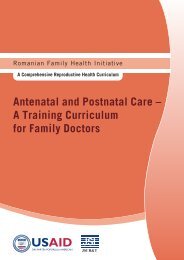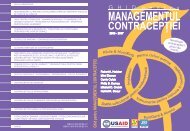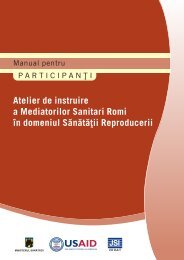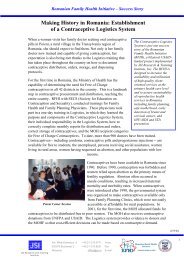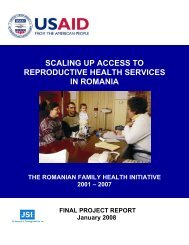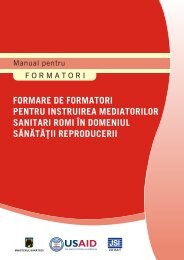Training of Roma Health Mediators in Reproductive Health
Training of Roma Health Mediators in Reproductive Health
Training of Roma Health Mediators in Reproductive Health
You also want an ePaper? Increase the reach of your titles
YUMPU automatically turns print PDFs into web optimized ePapers that Google loves.
- What will you and your partner do to prevent pregnancy dur<strong>in</strong>g the fertile<br />
days?<br />
- Can you th<strong>in</strong>k <strong>of</strong> situations when avoid<strong>in</strong>g sex might create a problem <strong>in</strong><br />
your relationship?<br />
- What has your partner’s reaction been <strong>in</strong> the past when you haven’t<br />
wanted to have sex?<br />
- Have both <strong>of</strong> you talked about what you will do to prevent pregnancy<br />
dur<strong>in</strong>g the fertile (white bead) days?<br />
- How might you and your partner let each other know on which days you<br />
can have sex?<br />
- What problems do you th<strong>in</strong>k you both may have us<strong>in</strong>g this method?<br />
9. Are both partners free <strong>of</strong> risk for sexually transmitted <strong>in</strong>fections?<br />
This question is designed to determ<strong>in</strong>e if the woman perceives that there may be a risk <strong>of</strong><br />
sexually transmitted <strong>in</strong>fection (STI) and to <strong>in</strong>form her that the SDM does not protect<br />
aga<strong>in</strong>st HIV/AIDS or STIs. In circumstances where either partner has sex with more than<br />
one person, there may be a risk.<br />
Recommended questions:<br />
- People who have sex with more than one person are at risk for gett<strong>in</strong>g a<br />
sexually transmitted <strong>in</strong>fection. S<strong>in</strong>ce you have been <strong>in</strong>volved with your<br />
current partner, have either <strong>of</strong> you been diagnosed with a sexually<br />
transmitted <strong>in</strong>fection?<br />
- How likely is it that either <strong>of</strong> you might be at risk <strong>of</strong> gett<strong>in</strong>g a sexually<br />
transmitted <strong>in</strong>fection?<br />
10. When can a woman who meets the eligibility criteria start us<strong>in</strong>g the SDM?<br />
If she has decided to use the SDM, help her determ<strong>in</strong>e when she can beg<strong>in</strong> us<strong>in</strong>g the<br />
method.<br />
• Women who remember the date <strong>of</strong> their last period can start us<strong>in</strong>g the method<br />
immediately by plac<strong>in</strong>g the r<strong>in</strong>g on the correct bead. For a woman who is past<br />
cycle day 7 when she starts the SDM, tell her she may already be pregnant if she<br />
has had unprotected sex this cycle.<br />
• Women who don’t remember the start date <strong>of</strong> their last period can beg<strong>in</strong> us<strong>in</strong>g the<br />
SDM on the first day <strong>of</strong> their next period. They should use another method until<br />
they can start the SDM.<br />
• Women who are post-partum or breastfeed<strong>in</strong>g should wait until they have four<br />
periods and the last one is between 26 to 32 days long to start us<strong>in</strong>g the SDM.<br />
• Women who have recently used the 3-month <strong>in</strong>jection should wait until 3 months<br />
have passed s<strong>in</strong>ce the last shot and her last cycle is between 26 to 32 days long.<br />
• Women who have recently stopped the pill or any other hormonal method, and<br />
women who have had a miscarriage, abortion, or used emergency contraception<br />
can start the SDM on the first day <strong>of</strong> their next period. These women should use a<br />
back-up method until they’re able to start us<strong>in</strong>g the SDM.<br />
96<br />
RFHI <strong>Tra<strong>in</strong><strong>in</strong>g</strong> <strong>of</strong> RHMs <strong>in</strong> <strong>Reproductive</strong> <strong>Health</strong> Session 5: SDM



